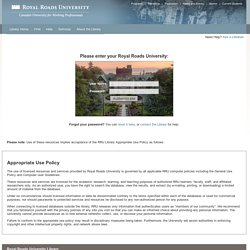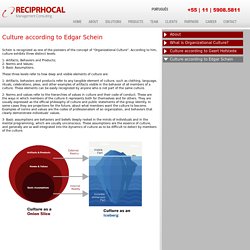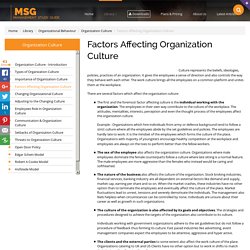

Login. Please enter your Royal Roads University: The use of licensed resources and services provided by Royal Roads University is governed by all applicable RRU computer policies including the General Use Policy and Computer user Guidelines.

These resources and services are licensed for the academic research, learning, and teaching purposes of authorized RRU learners, faculty, staff, and affiliated researchers only. As an authorized user, you have the right to search the database, view the results, and extract (by e-mailing, printing, or downloading) a limited amount of material from the database. Organizational Culture and Leadership, 3rd Edition. Culture according to Edgar Schein « Schein is recognized as one of the pioneers of the concept of “Organizational Culture”.

According to him, culture exhibits three distinct levels: 1- Artifacts, Behaviors and Products; 2- Norms and Values; 3- Basic Assumptions. Factors Affecting Organization Culture. Culture represents the beliefs, ideologies, policies, practices of an organization.

It gives the employees a sense of direction and also controls the way they behave with each other. The work culture brings all the employees on a common platform and unites them at the workplace. There are several factors which affect the organization culture: Culture and Decisions in Higher Ed. Academe is full of culture clashes -- administrators vs. faculty members, professional programs vs. the traditional liberal arts disciplines, government or business values vs. academic values.

William G. Tierney's new book explores the different cultures of higher education and how they explain the way decisions are made. The book is The Impact of Culture on Organizational Decision-Making: Theory and Practice in Higher Education (Stylus). Organizational Culture in Higher Education. What It Means to Work Here. It’s the HR equivalent of keeping up with the Joneses: In their quest to find and retain top talent, businesses often try to match competitors’ offers, ensuring that their compensation schemes, health care benefits, training programs, and other talent-management practices are in line with the rest of the industry’s.

While this strategy may be useful for bringing job candidates to the door, it’s not necessarily the most effective way to usher the right people across the threshold—great employees who will be enthusiastic about their work and fiercely loyal to the organization and its mission. Nor does marching in lockstep with industry standards prompt companies to consider what’s unique about their histories and values or potential employees’ attitudes about work.
Certainly, reasonable pay and a breadth of health care options matter to prospective hires, as do the tasks they’ll have to perform. Imagine yours is one of three job offers a talented candidate is mulling over.